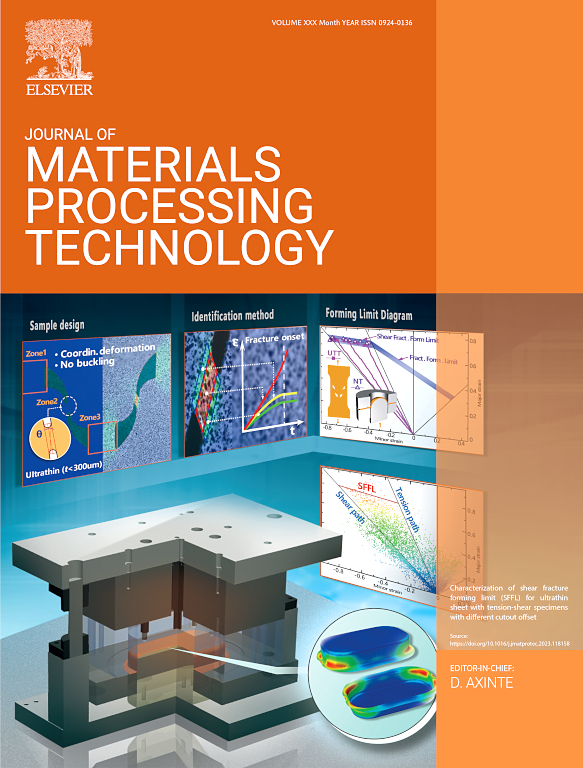Investigation on the movement mechanism of reinforcements during the melt static holding of SiCp-Cf/Al matrix composites
IF 7.5
2区 材料科学
Q1 ENGINEERING, INDUSTRIAL
Journal of Materials Processing Technology
Pub Date : 2025-07-12
DOI:10.1016/j.jmatprotec.2025.118983
引用次数: 0
Abstract
The distribution of reinforcements in the melt is a key factor influencing the preparation of high-performance aluminium matrix composites by stir casting. The movement behaviour mechanism of hybrid reinforcements in melt remains unclear due to the significant density differences between silicon carbide, carbon fiber, and the Al matrix, hindering the fabrication of high-performance hybrid reinforced Al matrix composites. Therefore, this paper employs the stirred casting method to prepare a SiCp-Cf/Al matrix composite melt. The effects of different reinforcement additions, melt static holding temperatures, and vacuum environments on the reinforcement movement behaviour were investigated. The results indicate that under atmospheric conditions, both SiC particles and carbon fibers exhibit upward flotation in the melt. An increase in the amount of reinforcement leads to a higher collision frequency and greater frictional resistance during particle movement, thereby slowing the flotation of the hybrid reinforcement. Increasing the static holding temperature enhances the Brownian motion of the reinforcements and reduces the melt viscosity, thereby decreasing the constraints on reinforcement movement and accelerating the flotation of the hybrid reinforcement. Vacuum-assisted stir casting demonstrates that reducing gas entrapment effectively mitigates the flotation of reinforcements. The reinforcement surfaces are wrapped by a micro-bubble layer, resulting in a combined density of the reinforcement and bubble layer that is lower than that of the melt, thereby causing the upward flotation of reinforcements. This study provides theoretical guidance for the preparation of novel hybrid reinforced Al matrix composites.
SiCp-Cf/Al基复合材料熔体静持过程中增强材料运动机制的研究
增强剂在熔体中的分布是影响搅拌铸造制备高性能铝基复合材料的关键因素。由于碳化硅、碳纤维和Al基之间存在显著的密度差异,混杂增强材料在熔体中的移动行为机制尚不清楚,这阻碍了高性能混杂增强Al基复合材料的制备。因此,本文采用搅拌铸造法制备SiCp-Cf/Al基复合材料熔体。研究了不同补强剂添加量、熔体静态保温温度和真空环境对补强剂运动行为的影响。结果表明:在常压条件下,碳化硅颗粒和碳纤维在熔体中均表现为向上浮选;增强剂用量的增加会导致颗粒运动过程中碰撞频率的增加和摩擦阻力的增大,从而减缓混合增强剂的浮选。提高静保温温度增强了增强剂的布朗运动,降低了熔体粘度,从而减少了对增强剂运动的约束,加速了混杂增强剂的浮选。真空辅助搅拌铸造表明,减少气体夹持有效地减轻了增强剂的浮选。增强材料表面包裹有微泡层,使增强材料与微泡层的结合密度低于熔体的密度,从而使增强材料向上漂浮。该研究为新型杂化增强铝基复合材料的制备提供了理论指导。
本文章由计算机程序翻译,如有差异,请以英文原文为准。
求助全文
约1分钟内获得全文
求助全文
来源期刊

Journal of Materials Processing Technology
工程技术-材料科学:综合
CiteScore
12.60
自引率
4.80%
发文量
403
审稿时长
29 days
期刊介绍:
The Journal of Materials Processing Technology covers the processing techniques used in manufacturing components from metals and other materials. The journal aims to publish full research papers of original, significant and rigorous work and so to contribute to increased production efficiency and improved component performance.
Areas of interest to the journal include:
• Casting, forming and machining
• Additive processing and joining technologies
• The evolution of material properties under the specific conditions met in manufacturing processes
• Surface engineering when it relates specifically to a manufacturing process
• Design and behavior of equipment and tools.
 求助内容:
求助内容: 应助结果提醒方式:
应助结果提醒方式:


